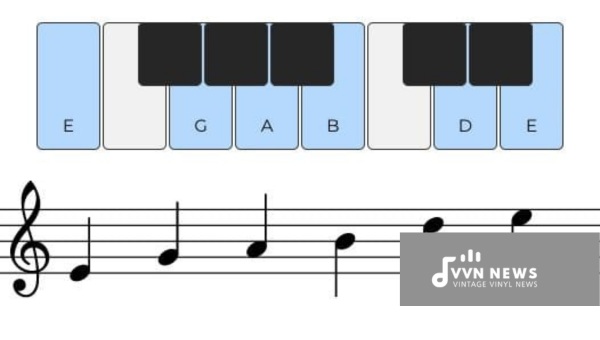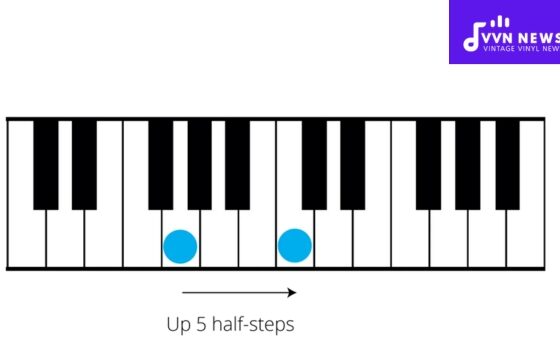Navigating the vast landscape of music theory can initially be quite daunting, but certain scales and chords offer a perfect starting point, and the E minor pentatonic scale is one of them.
This simple yet soulful scale is a cornerstone in a multitude of musical genres, from Blues and Rock to Jazz and Country.
It’s like a magic key that opens doors into varied realms of music creation.
When I first started learning guitar, the pentatonic scale was my stepping stone into the expansive world of solos and improvisations.
Its beautiful balance between simplicity and versatility was appealing to me as a beginner.
Now, let’s journey together through the intriguing nuances of the E minor pentatonic scale.
We’ll discover why it’s such an essential part of music theory and how it can become your secret weapon for expressive improvisation.
What is the E Minor Pentatonic Scale?
The E minor pentatonic scale, at its core, is a 5-note scale (‘Penta meaning five, and ‘tonic’ indicating tone) with its root note on E.
This scale follows a specific formula of whole and half steps to form five distinct notes in an octave – E, G, A, B, D.
Utilized heavily in various music genres, this scale excels in creating soulful melodies and harmonies.
Its beauty lies in its elegant simplicity – making it easy to learn yet packed with immense expressive power.
It’s composed of two minor intervals – the minor third (from G to E) and seventh (from D to E), which give this scale a unique melancholic characteristic.
Procedure to Construct the E Minor Pentatonic Scale

The minor pentatonic scale is built using the 1st, 3rd, 4th, 5th, and 7th notes of the natural minor scale—omitting the 2nd and 6th.
Thus, your simplified version retains its minor quality while reducing complexity.
About the E minor pentatonic scale:
- Identify each note in the E natural minor scale; these consist of E, F#, G, A, B, C, and D.
- As per the rules of minor pentatonic generation—remove the second (F#) and sixth (C) degree from this line-up.
- So now we’re left with E (the root), G (minor third), A (perfect fourth), B (perfect fifth), and D (minor seventh).
- Lastly, perform your fingering practice. Begin at “E” on your instrument & navigate through your remaining notes: E-G-A-B-D.
Your finalized result is a stripped-down rendition of the more complex natural scheme; it emphasizes what’s necessary to maintain a tonal feel but denies any overbearing dissonance that could detract from melody beauty.
Also Read: E Flat Minor Pentatonic Scale [Master This Key With Our Guide]
The Five Positions of the E Minor Pentatonic Scale
If you are passionate about delving deep into the wonderland of guitar solos, it is crucial to familiarize yourself with each layout or ‘shape’ of the E minor pentatonic scale.
Let’s delve into these five shapes, taking note of their unique structure and position on the fretboard.
The Home Box
The proverbial ‘home’ box – so-called because of its comfortable and accessible positioning – starts on the open low E string.
The notes in this shape are E (open), G (3rd fret), A (open), B (2nd fret), D (open), and back to E on the second fret of the D string.
Get comfortable with this shape as it is often your jumping-off point for further exploration.
The Extended Shape
Moving two frets up from our ‘home’ box, we find ourselves in what’s referred to as the extended shape.
This shape begins with G on the third fret of low E, extends upward to B on the 7th fret, then finishes its octave at G on the fifth fret of D.
Masters’ Playground
This adaptable form incorporates a wider range than previous positions, offering increased flexibility for riff creation.
Beginning from A on the fifth fret upwards to D on the 10th, this canvas offers your fingers plenty of space to dance upon.
Upper Neck Territory
Rarely ventured by beginners but loved by professionals, this shape commences its run from B at the 7th fret Navigating upwards through three octaves ending back at B, tenth fret high E – this realm offers an exciting playing field for adventurous soloists.
Final Control Zone
This last formation begins with a D played at the tenth fret low E string before climbing up through three octaves to return to D at the 15th fret on the B string.
This is a realm for crafted solos and meticulous phrases.
These five shapes can take your skills from basic strumming to weaving intricate solos, bringing new depth not only to your playing ability but also to your appreciation of the instrument itself.
What’s the related minor and major scale to the E Minor Pentatonic Scale?

Certainly, the E minor pentatonic holds a unique place in music, yet it shares intimate connections with other scales.
In particular, let’s delve into the E minor and G major scales, which both share the same key signature as our beloved pentatonic.
E Minor Scale
On one hand, we have the E minor scale, also referred to as the relative minor of this scenario. It shares all its notes with the G major scale.
However, what makes it distinct is its tonal center or root note – which is E on this scale. Let’s take a look at how these particular scales correlate:
- E (Root)
- F#
- G
- A
- B
- C
- D
G Major Scale
On the other hand, resides the G major scale, known as the relative major for our highlighted pentatonic scale in this discussion.
The amazing aspect is that it also contains similar pitches but begins with a G, creating an entirely distinct sonic atmosphere:
- G (Root)
- A
- B
- That said imply C
- That said imply D
- That said imply E
- That said imply F#
So how does this all relate to our E minor pentatonic? Simplify put- every single note in our 5-note E minor pentatonic also resides within both of these 7-note scales.
It’s an intricate interplay – like dancers moving individually but still enmeshed within the same choreography – that enhances and enriches your grasp on music theory.
Also Read: G Minor Triad [Demystify This Common Guitar Chord]
How to effectively practice the E Minor Pentatonic Scale with accompaniments?
Mastering the E minor pentatonic scale involves more than just learning its notes.
It also demands training your fingers to move smoothly between them and acclimating your ear to their sounds.
This task may seem challenging at first, but by breaking it down into smaller, manageable steps, you can achieve proficiency in this alluring musical tool.
Start with Slow Practice Routines
Firstly, it’s vital not to rush the process. Start by playing through the scale slowly and precisely. You may be eager to speed up, but patience is key at this stage.
Emphasize accuracy over speed and focus on creating a clean sound with each note.
Incorporate a Metronome
As you get comfortable with the notes and finger placements of the E minor pentatonic scale, bring in a metronome to help develop your timing and rhythm skills. Begin at a low bpm (beats per minute), and gradually increase it as your technique improves.
Play Along with Songs
There’s nothing like applying what you’ve been practicing to real music. Pick some songs that use the E minor pentatonic scale and try to play along.
This is where that “magic key” really shines—allowing you to explore various expressions within different song contexts.
Use Backing Tracks
One of the best ways to practice scales is by using backing tracks in compatible keys—it offers an excellent opportunity for improvisation.
Backing tracks are pre-recorded musical accompaniments that allow you to focus solely on mastering your scale while also providing context for how it fits into actual music.
Master Different Positions
Lastly, challenge yourself by learning different positions of the E minor pentatonic scale across the fretboard—it broadens your range considerably.
By adhering to these steps consistently while allowing yourself room for creativity, it won’t be long before the E minor pentatonic scale becomes an integral part of your musical arsenal.
Why is Ear Training Essential for the E Minor Pentatonic Scale?

One might wonder, “Why should I train my ears for the E minor pentatonic scale?” Here’s an enlightening fact I have gleaned over years of studying music theory.
Having enhanced auditory skills benefits you by making sense of the sounds that you play, which is vital in a performer’s arsenal.
Gaining a Sonic Perspective
Principally, ear training allows us to discern the unique sonic signature of this scale.
The E minor pentatonic scale comprises five notes – E, G, A, B, and D. Each note imbues a particular shade of emotion and resonance to the rhythm.
Training your ear helps in recognizing this blend, where each note fits into the bigger orchestral picture.
Expanding Musical Vocabulary
Training your hearing in tactics like pitch recognition and melodic dictation sharpens musical intuition within you – growing your vocabulary beyond notations and chords.
Recognition of sound patterns forms an integral part of ear training. For instance, knowing how “E” feels compared to “B” or “A” lends you greater control over playing songs or writing compositions.
Enhancing Improvisation Skills
The E minor pentatonic scale is exceedingly popular for solo improvisations due to its simplicity and versatility.
Ear training plays an integral part in improvisation as it lets you anticipate what comes next in terms of melody and harmony instinctively, without having to consciously think about it.
Reinventing Musical Prowess
Enhanced hearing abilities contribute to a versatile palette of musical skills where you can experiment with different techniques such as bending notes or adding vibrato on specific notes within this scale.
Ear training is akin to learning a language – it’s how we express music more effectively and creatively.
For mastering scales such as the E minor pentatonic one, it acts as an indispensable tool, honing your instincts and aiding you to craft compelling musical narratives.
Famous Songs Utilizing E Minor Pentatonic Scale
Before delving into the repertoire, let me clarify that the beauty of the E minor pentatonic scale lies in its versatility.
Many songs, spanning several genres, have successfully leveraged this scale to create appealing tunes and unforgettable solos.
Here we gather some sterling examples that affirm the vibrant diversity of this scale.
Rock and Blues
Robustly present in rock-and-roll melodies, ‘Stairway to Heaven’ by Led Zeppelin stands tall among those rocking the E minor pentatonic scale.
Robert Plant’s iconic solo in this track particularly showcases the effective utilization of this fascinating scale.
If you’re looking for a more bluesy temperament, ‘Black Magic Woman’ by Santana proves an excellent study.
The enchanting guitar riffs flow primarily from the E minor pentatonic scale, giving the song its intoxicating texture.
Pop and R&B
Moving towards more modern genres, check out ‘Low Life’ by Future ft. The Weeknd.
This popular 2016 hit from Billboard 100 prominently features the E minor pentatonic scale elements contributing dramatically to its catchy structure.
Finally yet important is Rihanna’s hit song ‘Diamonds’. The song’s melody is based on our key subject – yes, you guessed it right -E Minor Pentatonic Scale.
These examples offer you a sense of the potential of this simple but versatile scale across vast musical landscapes without any repetition or excessive recurrence of specific terminologies.
More importantly, they prove how even as an amateur or seasoned musician you have been interacting with various forms of E minor pentatonic sounds without necessarily realizing it.
Also Read: A Flat Minor Triad [Guide to Unusual Guitar Chords]
FAQs About The E Minor Pentatonic Scale
What is the fundamental difference between the E minor scale and the E minor pentatonic scale?
The primary difference lies in the number of notes; the E minor scale consists of seven notes, while the E minor pentatonic scale is composed of five unique tones.
Why is the E Minor Pentatonic scale so popular for guitar solos?
The layout of this scale on a guitar’s fretboard, combined with its versatile and melodic sound, makes it an excellent choice for creating memorable guitar solos.
Can I play other music genres apart from Blues with an E Minor Pentatonic Scale?
Absolutely! While famous in Blues, this scale is also integral to Rock, Metal, Country, and even Jazz music genres.
I am a beginner. Is it easy to learn the E Minor Pentatonic Scale?
Definitely. Despite its sophisticated sound, this scale is relatively simple to understand and play, making it a perfect starting point for beginners.
What role does ear training play when learning the E Minor Pentatonic Scale?
By developing your ear training skills, you can enhance your ability to recognize, replicate, and improvise with this scale more efficiently.
Conclusion
Mastering the E Minor Pentatonic Scale is an essential stepping stone in your musical journey.
Its versatility lies in its simplicity – only five notes, but oh so many possibilities!
It takes practice and patience, but once you master it, you’ll find these melodies seep into your improvisations and compositions, bringing them to life. So go forth and experiment with this humble scale.
In its simplicity, you will find an expressive tool to communicate your unique musical voice.








